Digging into the Bipartisan Infrastructure Framework – What’s Important for Ag
TOPICS
Wildfires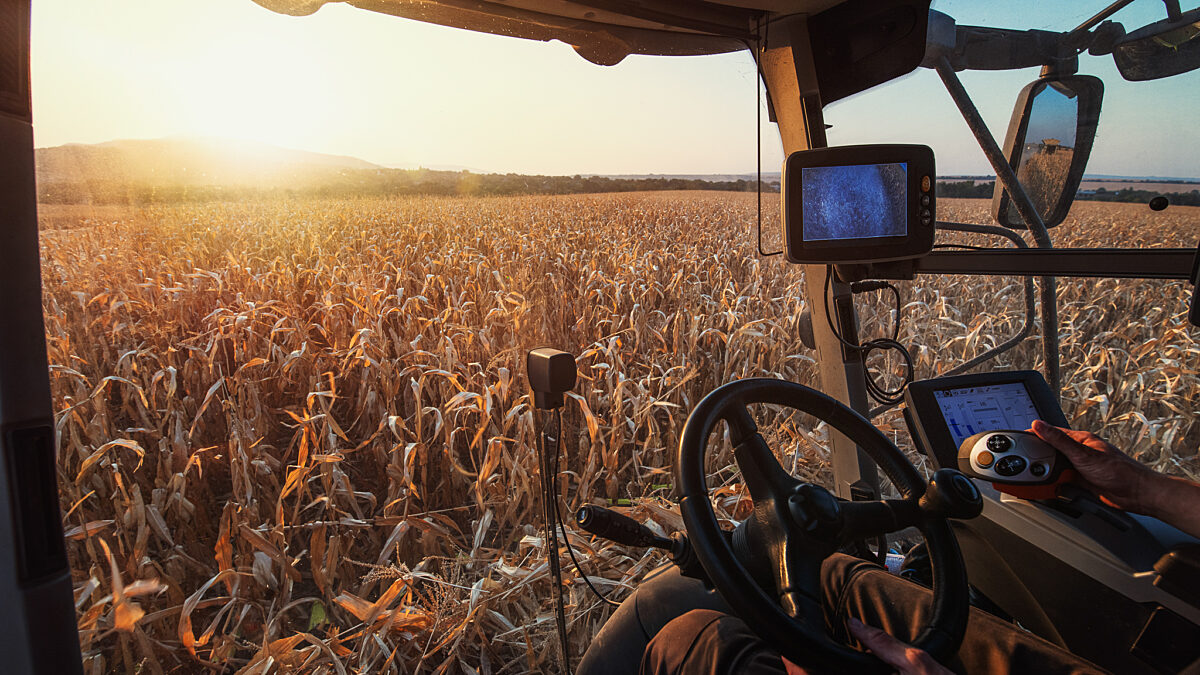
photo credit: Getty
Daniel Munch
Economist
After months of negotiation, the Infrastructure Investment and Jobs Act, also known as the Bipartisan Infrastructure Framework (BIF), passed both chambers of Congress and was signed into law by President Biden on Nov. 15. Designed to target investments to a slew of infrastructure shortfalls across the nation, the law provides approximately $1.2 trillion in funds. Today’s article provides a summary of the funding outlays, with a focus on allotments intended to support farm and ranch families and their rural communities.
Of the $1.2 trillion in estimated funds detailed under BIF, $550 billion represents new spending. The remaining $650 billion is pre-allotted funds for highways and other scheduled projects. Of the $550 billion in new spending, 52%, or $284 billion, is dedicated to surface transportation improvements, with the remaining $266 billion linked to core infrastructure projects further detailed in Figure 3. New spending pay-fors include $210 billion from repurposed 2020 COVID-19 relief funds, representing 38% of the $550 billion cost.
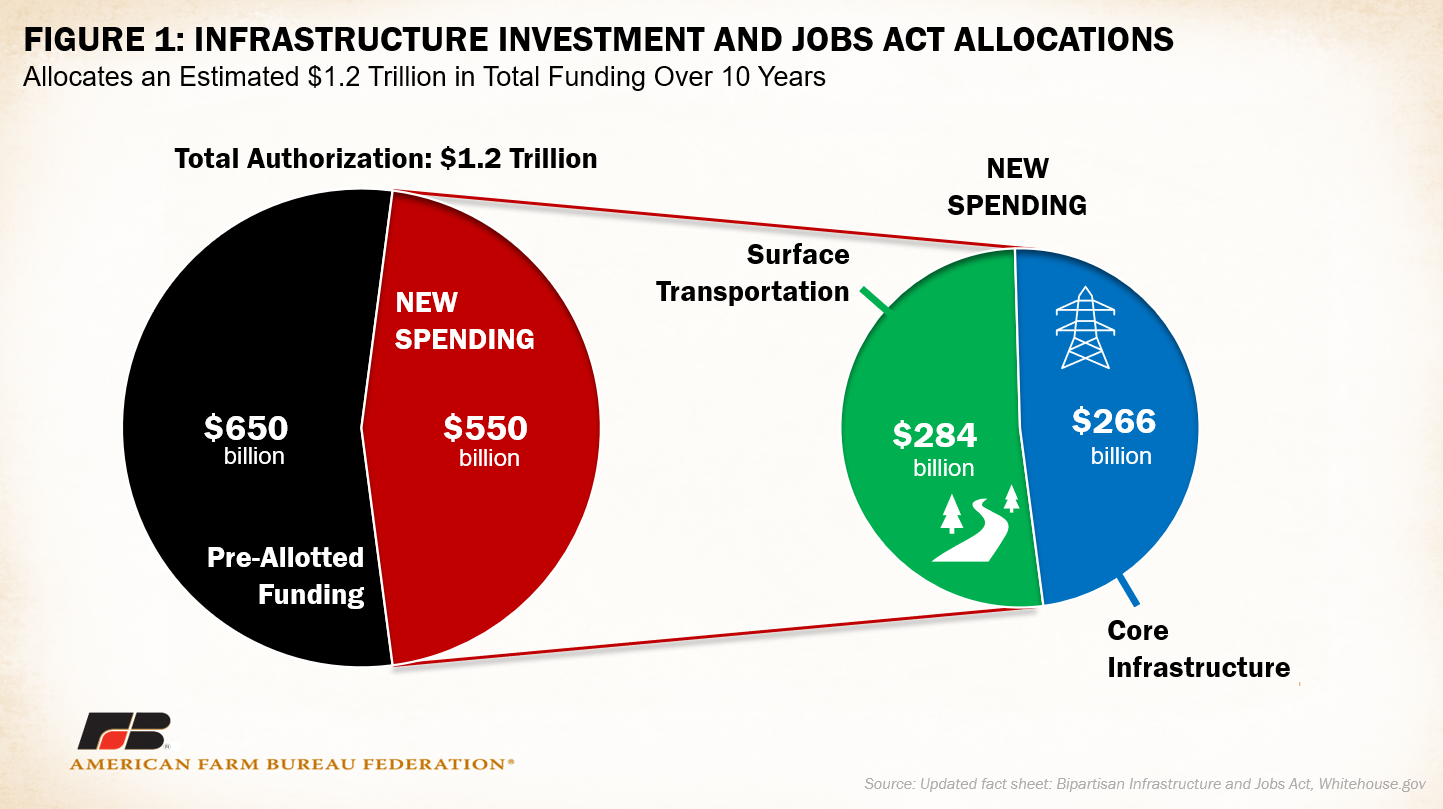
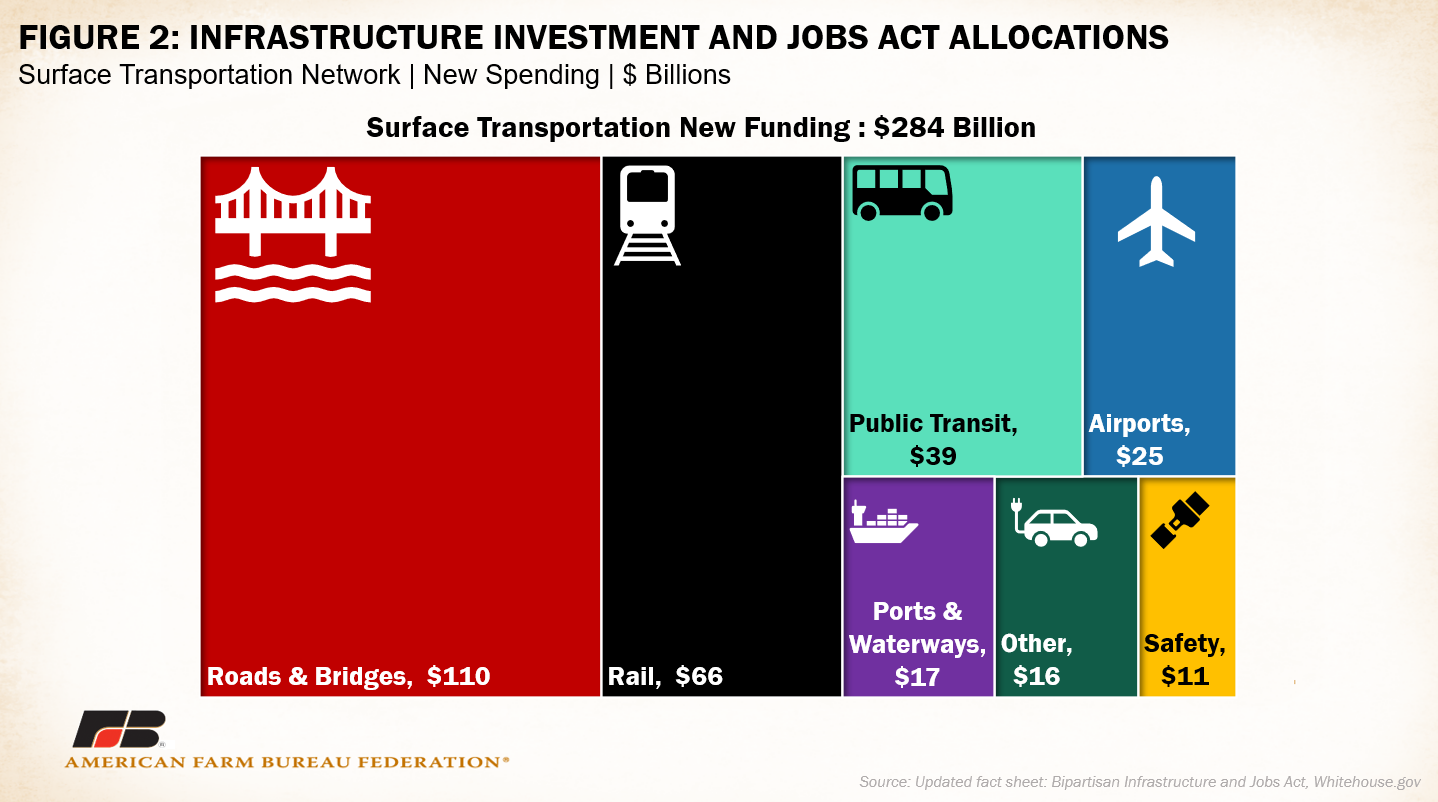
Surface Transportation Network
A breakdown of the $284 billion in surface transportation outlays is presented in Figure 2. Estimates indicate over 173,000 miles of highways and major roads and 45,000 bridges are in poor condition, posing challenges for rural communities that have fewer transportation options for conducting business and accessing food, health care and education. Over the next five years, $110 billion of this category is dedicated to improvements to roads, bridges and highways. This includes $40 billion in new funding for bridge repair, replacement and rehabilitation through the Bridge Investment Program, which is designed to reduce the number of bridges in poor condition or are at risk of poor condition in the next three years. Additionally, $2 billion of these funds establishes a new rural transportation grant program allowing eligible rural counties to apply for funding of highway and bridge projects to increase connectivity, improve safety and facilitate movement of goods using a federal cost share of 80%.
The $66 billion to boost rail networks incudes single- and multi-year grant programs to improve regional economic mobility and safety features of the rail system. Terminal improvements can help relieve capacity constraints that have contributed to increased rail freight rates for farmers and ranchers moving products far and wide. Relatedly, the $17 billion dedicated to ports and waterways brings needed investment to a network unable to keep up with record imports and associated wait times for ocean barges. This includes $9.6 billion designated for Army Corps of Engineers priorities such as $5.2 billion for new construction. Safety allocations include highway and pedestrian safety provisions and pipeline safety and repair. Categories under “other” include the replacement of school buses and ferries, with a priority on low income and rural areas. Electrical vehicle charging infrastructure is also included, with a particular focus on hard-to-reach communities.
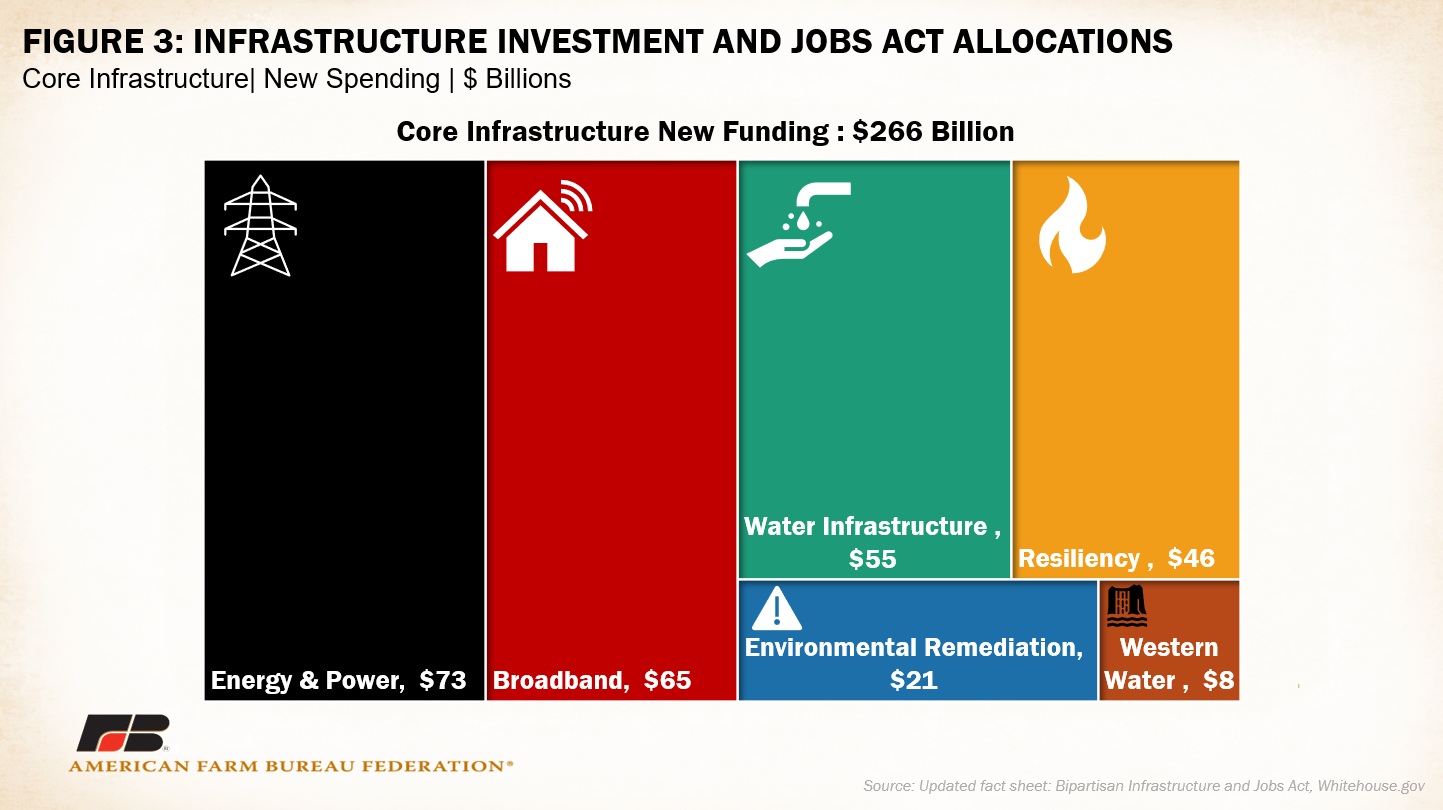
Energy & Power
Figure 3 displays a breakdown of outlays categorized as core infrastructure. The $266 billion allocation includes over $70 billion for energy and power grid improvements. It is estimated power outages cost the U.S. economy up to $55 billion annually exacerbated by natural disasters from coast to coast. Outlays for modernizing the power grid include general grant programs to reduce the impact of extreme weather, wildfire and natural disasters on the power system. It also includes monies to incentivize battery production and manufacturing in the United States ($3 billion).
Broadband
Over 30 million Americans have little or no access to high-speed internet. Included in broadband funding of $65 billion is $42.45 billion for the Broadband Equity, Access, and Deployment Program, which will make grants to states for broadband deployment – improving high speed internet access across rural areas. Projects would have to meet a minimum upload/download standard of 100/20 megabits per second. All funding recipients must offer low-cost plans in order to receive funding. An additional $2 billion is set aside to support programs managed by USDA, including the ReConnect Program, that provide loans and grants to fund acquisition, construction and maintenance of facilities providing service in rural areas. To increase competition and lower operating costs, $1 billion is allocated for a “middle mile” grant program to support the construction, improvement and acquisition of middle mile infrastructure that will connect to last mile networks. $4.75 billion is set for the Tribal Broadband Connectivity Program and Digital Equity Act for broadband deployment, workforce development, telehealth and distance learning. $14.2 billion is used to create a permanent Affordable Connectivity Benefit to ensure low-income families can access the internet. Lastly, $600 million is set to allow states to issue Private Activity Bonds to finance broadband deployment in rural areas where a majority of households do not have access to the internet.
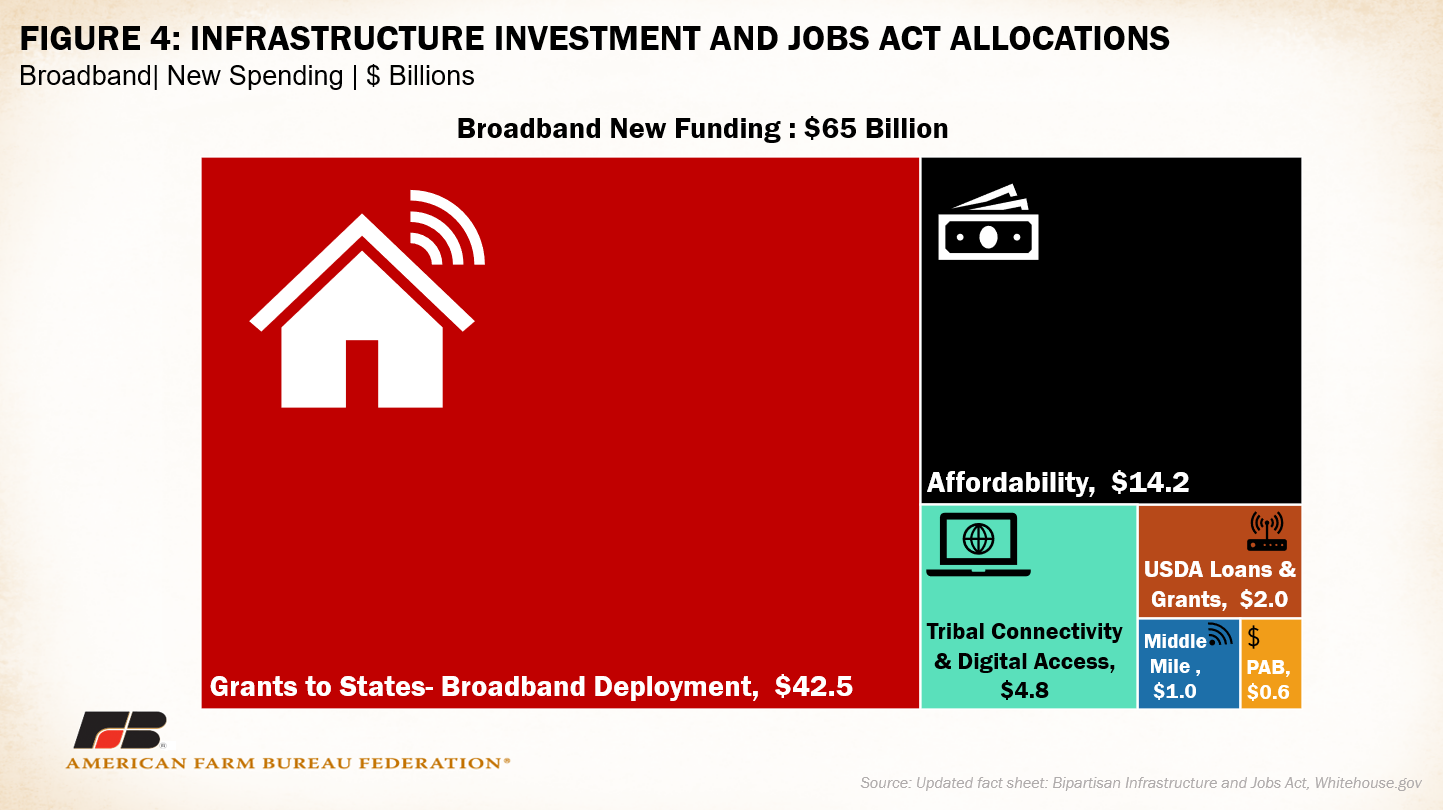
Water Infrastructure & Western Water Storage
The $55 billion for water infrastructure includes $43.4 billion for State Revolving Loan Funds to fund water infrastructure improvements and lead service line replacements. The $8.3 billion authorized for Western water infrastructure includes $3.2 billion for aging infrastructure and $1.2 billion for water storage, groundwater storage and conveyance projects. Another $1 billion is allocated for water recycling projects. $300 million is set for drought contingency plans including $50 million for Upper Basin states.
Resiliency & Environmental Remediation
The $46 billion for resiliency includes $7 billion for Army Corps of Engineers flood mitigation priorities. $10 billion is set aside for a bioproduct pilot program at USDA in partnership with land grant universities to study the benefits of using materials derived from agricultural commodities in the production of consumer and construction products. Separately, $918 million is set aside over five years for USDA's watershed programs, with the largest share of the funding, some $500 million, going to the Watershed and Flood Prevention Operations program, which is administered through USDA's Natural Resources Conservation Service. Another $118 million is earmarked for the Watershed Rehabilitation Program, which provides assistance to renovate dams. Some $300 million is allocated for wildfire resilience in the Emergency Watershed Protection Program. Nearly $900 million will allow the Department of the Interior and the Forest Service to carry out hazardous fuel reduction projects. $21 billion in environmental remediation targets superfund sites.
Other Provisions
Sec. 23018 of the law includes an exemption for livestock and insect haulers from hours of service regulations within a 150 air-mile radius from their final destination.
Conclusion
The Bipartisan Infrastructure Framework attempts to address the numerous infrastructure shortfalls facing rural America. Vital funding to improve roads and bridges, increase capacity at ports and rail terminals and get families connected may lessen supply chain gridlock that has hindered farmers’ and ranchers’ abilities to operate. Further funding for aging Western water infrastructure and wildfire fuel reduction can relieve stress for thousands of businesses facing constant threats from drought and wildfire conditions. Other provisions support projects to make the power grid more secure, allow states and counties to access funds for backlogged projects, and reduce hours of service burdens on livestock haulers.
It is important to note BIF is separate from the Build Back Better Act currently under consideration by Congress. AFBF opposes Build Back Better because, as AFBF President Zippy Duvall noted in a letter to House lawmakers, the massive amount of spending and tax increases required to pay for the plan outweigh the gains for rural America.
